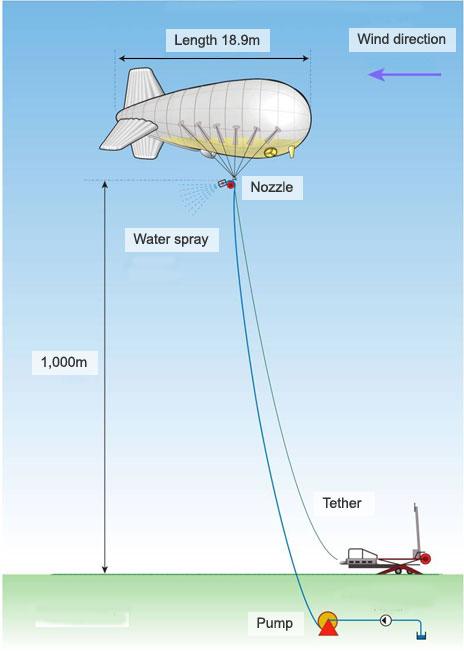UK climate fix balloon grounded
- Published

Not everyone thinks geoengineering is a "green" option for climate change
A pioneering UK project to test technology for a climate "tech fix" has been postponed for at least a year.
The <link> <caption>Stratospheric Particle Injection for Climate Engineering (Spice) project</caption> <url href="http://www2.eng.cam.ac.uk/~hemh/SPICE/SPICE.htm" platform="highweb"/> </link> would have pumped water droplets into the atmosphere from a tethered balloon.
The kit could then have been used to disperse tiny dust particles to cool the Earth, as volcanic eruptions do.
The Spice chiefs cite problems with regulations, intellectual property and public engagement.
Core to the decision was <link> <caption>a patent application</caption> <url href="http://worldwide.espacenet.com/publicationDetails/originalDocument?CC=GB&NR=2476518A&KC=A&FT=D&ND=1&date=20110629&DB=&locale=en_EP" platform="highweb"/> </link> filed by two Cambridge University researchers, Hugh Hunt and Chris Burgoyne, and Isle of Man-based businessman Peter Davidson, that covered much of the project's technology.
"The details of this application were only reported to the project team a year into the project lifetime and caused many members, including me, significant discomfort," said Spice project leader Matt Watson from Bristol University.
Dr Watson and some of the other academics believe as a matter of principle that experimentation into geoengineering, the nascent field of "technical fixes" for climate change, should be patent-free.
However, Dr Burgoyne said the application was made to protect the technology, not to turn a profit.
"I've never taken the view that this is something anybody will make money on - it's just saying 'we thought of this', so that if a company comes along and tries to patent it later, they can't," he told BBC News.
Talking time
The project funders, the Engineering and Physical Sciences Research Council (EPSRC), had earlier mandated a six-month delay in order to allow more engagement with concerned stakeholders.
The body is understood to feel that this process has not yet been taken far enough.
Another reason for the new postponement is that despite discussion in several international fora, including the UN Convention on Biological Diversity, there is still no comprehensive framework for governance on this sort of project.
"We have decided not to do this until the governance process is complete," said Dr Hunt.
"And given that we're running out of time, we're getting on with doing tests with kites instead - no water - just looking at how wind affects the kite string."
Water dropped
The balloon was originally due to go up last October from the disused Sculthorpe airfield in Norfolk.
It would have ascended to about 1km. Water would have been pumped up a pipe from the ground and out of a fine nozzle, with scientists monitoring how the droplets spread and how the balloon and tether responded to changing winds.
A total of about two bathloads of water would have been dispersed.

The postponed test would pump water droplets 1km above the ground
The team could have used the information gained to develop a much larger package that would go much higher up into the atmosphere and disperse fine sulphate aerosol particles that would reflect sunight back into space, cooling the Earth, just as happens with the dust released by major volcanic eruptions.
Reducing the amount of solar energy reaching the ground - solar radiation management (SRM) - is one of the two main geo-engineering approaches.

Deployment of a giant sunshield in space to reflect solar energy is another geoengineering idea
As well as sulphate aerosols, proposed methods include painting roofs white, planting crops with more reflective leaves and putting giant sunshields in space.
The other geoengineering approach seeks to remove carbon dioxide from the air.
Opponents, including several environment groups, point out that these technologies may carry unintended consequences, and say it is a distraction from the real task of reducing greenhouse gas emissions.
In addition, SRM techniques do nothing to tackle the gradual acidification of the oceans resulting from absorption of atmospheric carbon dioxide.
But proponents say research into these technologies is needed in case climate change progresses at such a rate that urgent action becomes necessary.
In this context, Dr Watson said the delay was regrettable.
"Any postponement of the 1km test would be a <italic>de facto</italic> cancellation as the experiment's value, to elucidate balloon and tether dynamics, diminishes over the project lifetime," he said.
"The Spice team sincerely hopes that this decision will facilitate rational, unrushed discussion on issues that include both governance and intellectual property but span broader issues surrounding solar radiation management (SRM)."
But the rest of the project is unaffected.
"It is regrettable that the field-trial aspect of Spice has now been cancelled; but it is vitally important that the remainder of the project, which is desk and lab based, should continue," commented Prof Peter Cox from Exeter University.
Follow Richard <link> <caption>on Twitter</caption> <url href="http://twitter.com/#!/BBCRBlack" platform="highweb"/> </link>
- Published24 October 2011
- Published30 September 2011